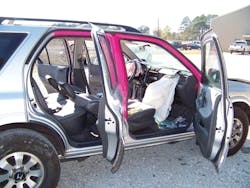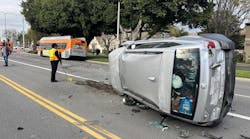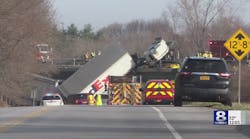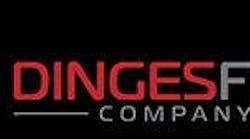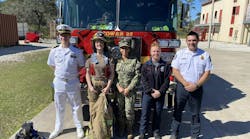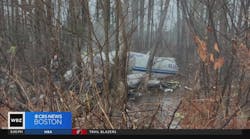SUBJECT: Advanced Steel
TOPIC: Extrication Challenges of Advanced Steel in Vehicles — Part 6
OBJECTIVE: The vehicle rescue instructor/trainer will conduct effective training that simulates the presence of Advanced Steel in an older, acquired vehicle.
TASK: Given an acquired vehicle for extrication training that does not have Advanced Steels in its structure, the vehicle rescue instructor/trainer shall take steps to simulate the presence of these steels in the vehicle and then shall assign the "work-around" techniques to rescue crews.
One of the most significant challenges today for vehicle rescue instructors is that we want our rescue teams to be able to handle entrapment situations involving new, late-model vehicles that have advanced steels such as Boron or Martensite integrated into their structure. Our reality as an instructor, however, is that it's next to impossible to get a new car to cut up that actually has this kind of steel in it. So, what do we do?
In Part 5 of this series on Advanced Steels, published in September of 2009, alternative rescue techniques were presented for crews that might encounter an entrapment situation involving advanced steel but not have a power rescue cutter that can cut through it. Referred to as advanced steel "work-around" techniques, it becomes very apparent that rescuers need to practice tasks such as the "Pie Cut", "Lifting the B-Pillar", "Spreading the B-Pillar", "Ramming the Roof Off", and "Total Sunroof" evolutions in training sessions.
There are two steps that an extrication instructor can take to better prepare their crews for just such a situation. The first step is to create an advanced steel simulation vehicle. The second step is assigning crews to complete "work-around" tasks on this older acquired vehicle.
To simulate the presence of advanced steel in an older, junk vehicle that is to be used for extrication training, a can of high-visibility spray paint is required. Prior to the start of your extrication training session, bright orange, yellow, green or florescent pink spray paint is applied to the side structure of a four-door vehicle. With the doors open, on the driver's side of this vehicle, paint the entire A-pillar, the entire B-pillar, and all of the rocker panel. Paint the C-pillar from the roofline down to just below the top edge of the door. Then skip the area near the door latch and finish by painting the lower portion of the C-pillar below the latch down to the rocker. This paint scheme simulates one advanced steel design used in selected General Motors vehicles.
On the passenger's side of the advanced-steel simulation vehicle, paint the A-pillar from the roofline down to the top front door hinge. Paint the roofline from the A-pillar rearward to the connection with the C-pillar. Finally, paint the B-pillar from the roofline down to the bottom hinge of the rear door. This paint scheme simulates one style of advanced steel used in Chrysler Motors vehicles.
Explain to your students that all painted edges of the structure on this car magically now contain advanced steel. Crews working on this car will simulate that they do not have a power rescue cutter tool that can get through this steel. They will have to accomplish "work-around" techniques that you will assign to them.
The instructor has to assign the "work-around" techniques on this vehicle in a very specific sequence. Following this order of tasks will allow the instructor to get the most value out of this one acquired vehicle.
The four-door vehicle is sitting on a level surface on its four wheels. The vehicle has been painted with high-visibility spray paint that is now dry. Participants in the class have been organized into small working teams for this training. The vehicle has to be stabilized. All four doors can actually be opened and cut off at the hinges. The instructor then follows the recommended order of tasks, assigning one task after another to the participant teams until all eight "work-around" tasks have been completed.
Assignment 1 — Driver's Side: Spreading B-Pillar to B-Pillar
Begin on the driver's side and assign a team to slightly widen the B-pillars as if one had been crushed inward due to a severe side impact. This crew must spread with a tool such as a power ram from B-pillar to B-pillar to simulate moving a crash-damaged pillar off of a driver trapped inside. It is not an easy task because the seatbacks will obstruct this spreading effort and many teams have power rams but they may not extend far enough to reach from one B-pillar to the other. Monitor roof movement as it may begin to lower into the vehicle as the B-pillars move outward.
Assignment 2 — Passenger's Side: Spreading Center Tunnel To B-Pillar
The second crew must also move a B-pillar away from the interior of the vehicle as if it had been pushed inward during a side impact. This crew, however, can only work their pushing or spreading tool on their half of the vehicle; from the floorboard center tunnel area to the passenger's side B-pillar. Again, push just enough to show that it can be accomplished in a real-world situation.
Assignment 3 — Passenger's Side: Lifting B-Pillar Up
For this third training assignment, efforts to cut through the pillar near the rocker channel are successful because there is no advanced steel in this lower area of the simulation vehicle. One popular Chrysler vehicle structural design has mild steel at the bottom of the B-pillar, spot welded to the main portion of the pillar. Once the B-pillar is cut through at the bottom, have the crew lift it up and away from the simulated trapped patient. The patient doesn't care if you lay the B-pillar down or lift the B-pillar up; they just want out. Leave it attached at the roofline for now.
Assignment 4 — Passenger's Side: Pie Cut
The fourth "work-around" assignment simulates that only the B-pillar contains advanced steel and not the roof rail. This design is used in late-model vehicles from Toyota Motors. For this task, the assigned team disregards the fact that the roof rail has been painted. The simulation is that it is possible to cut the roof rail on both sides of the top of the pillar in a "pie cut" fashion. Once the cuts are completed, the crew must lay the pillar down. (Note: At this training session, this effort removes the B-pillar from the car because it has already been cut off at the bottom by a previous crew.)
Assignment 5 — Driver's Side: Ram the Roof Off
When a rescue team cannot cut through a B-pillar or roof rail that contains advanced steel, a good "work-around" technique can be to ram the roof off the top of the B-pillar. Even though advanced steel may be present, a powerful ram may be able to push the roof rail up until it begins to tear free at the spot welds.
The assigned team must place additional cribbing beneath the rocker to support the force of the ram. After an initial push on one side of the B-pillar, a second push on the opposite side may be enough to completely tear the B-pillar away from the roof rail in a real-world situation. Once separated from the roof, the crew must practice bending the pillar down without making any additional cuts. It simulates not being able to cut the bottom of the pillar in a real-world scenario.
Assignment 6 — Driver's Side: Total Sunroof
On the driver's side of the painted vehicle, the assigned team encounters a vehicle with the A- and C-pillars containing advanced steel. The team must cut the roof panel from the front windshield header all the way back to the rear window following a line along the inside of the edge of the roofline. The tool of choice is a reciprocating saw.
After the full-length cut on one side, relief cuts can be made at the front and rear on the "hinge" side of the roof. The entire roof panel can then be lifted up and away from the simulated trapped patient below. Once the "total sunroof" evolution is completed at a real-world incident, the crew could push the sides of the vehicle away now that the roof has essentially been disconnected from the side structure of the vehicle.
Assignment 7 — Driver's Side: Dash & Instrument Panel Movement
The final two "work-around" techniques address a hard-impact frontal crash where we normally would roll the dash or jack the dash. The problem, however, with our advanced-steel simulation vehicle is that the A-pillars can't be cut. On the driver's side, assign a team to push directly on the intact A-pillar, the steering column, or on the dash support pipe that runs across the instrument panel with a tool such as a ram. Remember, if a real-world crash had occurred, these components would be pushed onto your patient. You are just moving them back to their original positions anyway. Remind them to sever the dash tie-down straps along the center tunnel if they exist.
Assignment 8 — Passenger's Side: Dash & Instrument Panel Movement
The assigned team on this side also must move the dash, instrument panel, and A-pillar away from a simulated front-seat occupant. Again, the upper portion of the A-pillar cannot be cut, but on this side the advanced-steel simulation ends at the bottom door hinge. The very bottom of the A-pillar can be cut.
TASK: Given an acquired vehicle for extrication training that does not have advanced steels in its structure, the vehicle rescue instructor/trainer shall take steps to simulate the presence of these steels in the vehicle and then shall assign "work-around" techniques to rescue crews.
RON MOORE, a Firehouse® contributing editor, is training chief for the McKinney, TX, Fire Department. He also authors a monthly online article in the Firehouse.com "MembersZone" and serves as the Forum Moderator for the extrication section of the Firehouse.com website. Moore can be contacted directly at [email protected].
